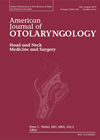
Journal Reviews
Retrospective review of paediatric salivary gland tumours
As is the case with adults, primary tumours of the salivary glands in children comprise a heterogeneous collection of different histological types. This paper presents a retrospective review of primary salivary gland tumours in children treated over the course of...
ChatGPT Quiz skills need refinement!
On 30 November 2022, ChatGPT was launched, free for all to use online. For those who are not aware, ChatGPT (Chat Generative Pre-trained Transformer) is an artificial intelligence (AI) chatbot which utilises the web to create detailed and natural human-like...
Parapharyngeal space tumours – is the transoral approach effective?
Several approaches are described to the parapharyngeal space to permit resection of tumours in this region, with the most commonly employed approach being the transcervical route. The transoral approach remains somewhat controversial as it is felt that this approach can...
Extracapsular dissection alone for low-grade malignancies of the parotid gland – oncologically sound?
The general treatment strategy advocated for a primary carcinoma of the parotid gland is surgical resection +/- adjuvant radiotherapy. A selective neck dissection is usually recommended in all cases of parotid malignancies, except for small, low-grade tumours. In this paper,...
How reliable are PTH levels for the prediction of hypocalcaemia after thyroid surgery?
Hypoparathyroidism is one of the most common complications of thyroid surgery. There is significant controversy in calcium management practices post thyroid surgery. The drop in PTH levels has been used to predict the likelihood of hypocalcaemia after thyroid surgery. But...
How to improve olfaction and enhance quality of life after laryngectomy
Total laryngectomy diverts airflow away from the nose and, hence, olfaction is greatly impaired. Undoubtedly, this affects quality of life in terms of loss of taste and flavour. Surgery and devices to re-establish airflow into the nose can be difficult...
Malignant transformation of leukoplakia in previous cancer patients
This is a retrospective study from Taiwan assessing risk factors in developing oral squamous cell carcinoma from surgically excised oral leukoplakia in patients with a previous oral cancer, the underlying thought being that patients with an oral carcinoma have a...
Relapse after bi-maxillary surgery in a class III malocclusion
This study analysed 90 patients who underwent a bi-maxillary osteotomy for a class III malocclusion. There were 30 in each of three groups of patients based upon the Frankfort mandibular plane angle (FMA). They were divided into: greater than 32°,...
Effects of coronavirus pandemic on presentation of head and neck cancer patients
The COVID-19 pandemic caused unprecedented disruption of NHS services. This was compounded by patients’ reluctance to attend hospitals at that time. How this affected the presentation of patients with head and neck cancer is the subject of this study. Head...
Liver function assessment in glandular fever
This month’s Editors’ Choice is a systematic review of the role of liver assessment in patients with glandular fever. Admission of patients with sore throat constitutes a significant burden of acute work for paediatric and adult ENT services as well...
Small but significant
These authors try to circumnavigate the conundrum of what is influenced by what. For something so small, the impact of the Stria Vascularis cannot be understated. The difficulty in reviewing the influence of loop diuretics or aminoglycosides on the Stria...
Adenotonsillectomy day-case discharge criteria: a systematic review
In this paper, Gowda et al review the literature aiming to answer a long-standing question regarding the criteria for same-day discharge of paediatric patients post adenoidectomy and/or tonsillectomy performed for treatment of obstructive sleep apnoea (OSA). Following PRISMA consensus, they...














